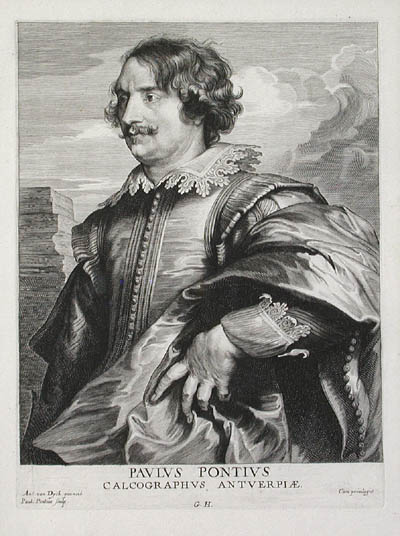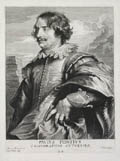| Title: |
Paulus Pontius, Calcographus Antwerpiae |
| Engraver: |
Pontius, Paulus (Antwerp, 1603 - 1658) |
| Designer: |
Van Dyck (Van Dyke), Anthony (Antwerp, Flanders, 1599 - 1641) |
| Date: |
1645 (First Published Edition by Gillis Hendricx, Antwerp) |
| Medium: |
Original Engraving |
| Note: |
Paulus Pontius (also known as Paulus Du Pont) is
perhaps the most esteemed engraver of both Rubens and Van Dyck. Born in
Antwerp, Paulus Pontius studied engraving techniques under Lucas Vorsterman.
He became a primary engraver of Rubens at the age of twenty and his first
dated Rubens engraving (Susannah and the Elders) bears the date
of 1624. During the following twenty years Rubens commissioned Pontius
to engrave many of his most famous paintings. Paulus Pontius became a
Master of the Antwerp Guild in 1626. |
| |
Paulus Pontius's engravings for Anthony Van Dyck are no less distinguished.
In total he engraved over forty portraits for Van Dyck, including a large
number for The Iconography. These include portraits of such painters
as Peter Paul Rubens and Gerard Seghers and of royalty such as Gustavus
Adolphus, King of Sweden, Mary de' Medici, Queen of France, and Frederick
Henry, Prince of Orange. One of his most interesting portraits, of course,
is Paulus Pontius. Although the portrait was designed by Van Dyck,
one can rest assured that Paulus Pontius was very familiar with the features
of the subject. With its beautiful use of lines and tonal contrasts it
is a brilliant example of Flemish Baroque art. |
| |
Anthony Van Dyck and "The Iconography":
The great age of portrait engraving took place in the early and mid seventeenth
century. In France such remarkable portrait engravers as Robert Nanteuil
and Antoine Masson achieved fame at least equal to the most highly regarded
painters. In Belgium and Holland the division between painter and engraver/etcher
was much less distinct. Rembrandt was as great an etcher as a painter
and both Rubens and Van Dyck conducted a school of engravers under their
close personal supervision. In the 1620's Peter Paul Rubens founded an
engraver's school in Antwerp in order to render his paintings and drawings
into copper. Such great engravers as Lucas Vorsterman (1595-1675), Boetius
a Bolswert (1580-1633) and Paulus Pontius (1603-1658) formed the cornerstone
of what was soon known as the 'School of Rubens'. |
| |
At the age of nineteen Anthony Van Dyck (Antwerp, 1599-1641)
was admitted into the painter's Guild of Antwerp, as a Master. A year
later he became the senior assistant to Rubens. A superb portraitist,
Van Dyck became famous throughout Europe and later was appointed court
painter to King James the First of England. |
| |
Van Dyck was first introduced to both engraving and etching
by Peter Paul Rubens. Around 1630 he began his most ambitious printmaking
project to create a uniform series of engravings of famous contemporaries
derived from his portraits. Van Dyck provided his engravers with extensive
preparatory work, including drawings and oil sketches. He then corrected
his engraver's proofs and even etched the outline features on some of
the portraits. In the following years he designed and supervised about
eighty such portrait engravings which were published individually by Martin
van den Enden. His principal engravers included Paulus Pontius, Nicolaes
Lauwers, Pieter de Jode, Lucas Vorsterman, Robert van Voerst and others.
These wonderfully graceful portrait engravings were a high point of Baroque
art and proved to be perhaps the most influential group of portraits in
the history of printmaking. |
| |
The first complete published set of The Iconography
did not appear until four years after Van Dyck's death, in 1645. During
this year Gillis Hendricx published a series of one hundred Van Dyck portrait
engravings in three general categories; I, Princes, II, Scholars, and
III, Painters, Engravers, Sculptors and Patrons of Art. (Interestingly,
portrayals of painters and engravers were deliberately placed on a level
equal to nobility and scholars. In Paulus Pontius, for example,
the sitter exudes both culture and aristocratic wealth. This is surely
no starving artist. ) The entire series now bore the title, Icones
Principum Vivorum Doctorum Pictorum ... Impressions from this first
published set contain the Gillis Hendricx letters, 'G. H.' along the lower
plate mark. |
| |
The demand for portraits from The Iconography was
so great that many subsequent editions were printed in the following decades.
The final edition was in fact published as late as 1759 and many of the
plates still survive in the Louvre. Detecting early from late impressions
of portraits from The Iconography however is not difficult. With
the deterioration of lines and contrasts, late impressions bear only a
ghostly relationship to first edition printings. Secondly, Gillis Hendricx
impressions were printed on a fine, laid paper with a distinct watermark
of a Foolscap containing five points, four large bells and braided hair
(seen in this impression in the lower margin). This watermark appears
on paper used in both Antwerp and Holland between 1640 and 1660. Lastly,
later impressions appear without the 'G. H.' along the lower plate-mark.
This impression of Paulus Pontius, then, is clearly from the 1645 edition. |
| Raisonne: |
F. Wibiral, L'Iconographie d' Antonie Van Dyck, Leipzig, 1877. |
| |
Catalogue #59. Fourth State, as published in the 1645 Hendricx edition. |
| Size: |
9 5/8 X 7 1/8 (Sizes in inches are approximate,
height preceding width of plate-mark or image.) |
| |
View larger Framed Image |
| |
 |
| Condition: |
Printed upon fine 17th century, hand-made, laid paper and
with wide, full margins as published in Antwerp in 1645 by Gillis Hendricx.
Containing the period foolscap watermark (as described) along the lower
margin, under the plate-mark. A brilliant, early impression and in excellent
condition throughout. Paulus Pontius, Calcographus Antwerpiae represents
a superb, original example of portrait engraving from the famous Iconography
of Anthony Van Dyck. |
| Price: |
Sold - The price is no longer available. |
| Important Information: |
The artist biographies, research and or information pertaining to all the original works of art posted on our pages has been written and designed by Greg & Connie Peters exclusively for our site, (www.artoftheprint.com). Please visit us regularly to view the latest artworks offered for sale. We will soon be posting an update of our most recent research and include the biographical and historical information pertaining to our next collection of original works of art created by artists throughout the centuries. We hope you found the information you were looking for and that it has been beneficial.
Our Gallery, (Art of the Print / www.artoftheprint.com) guarantees the authenticity of every work of art we sell 100%. Full documentation and certification is provided. We offer a wide selection of international fine art dating from the early Renaissance to the contemporary art period. |

















![]()
![]() or
phone Greg & Connie (905) 957-6666
or
phone Greg & Connie (905) 957-6666